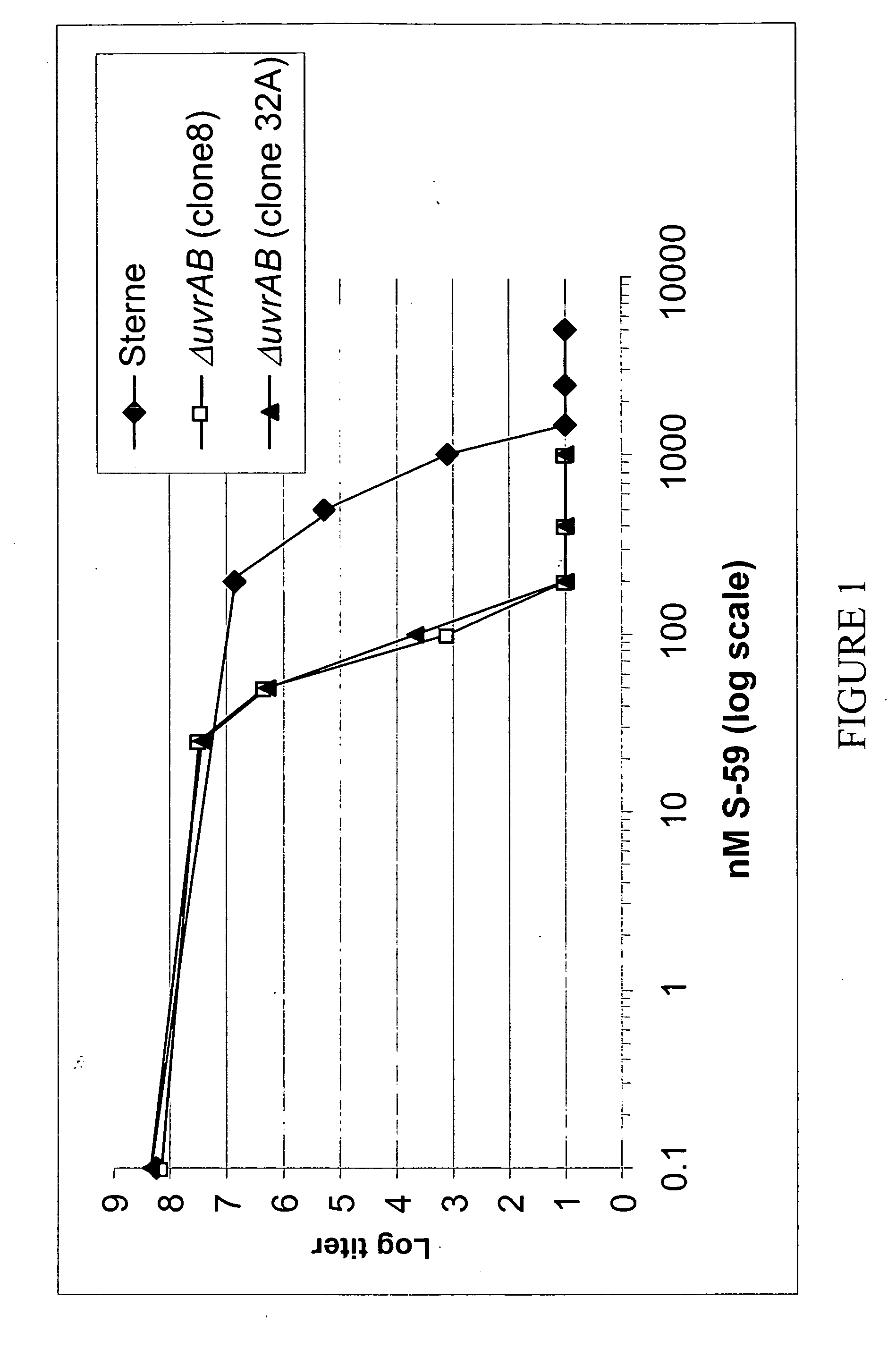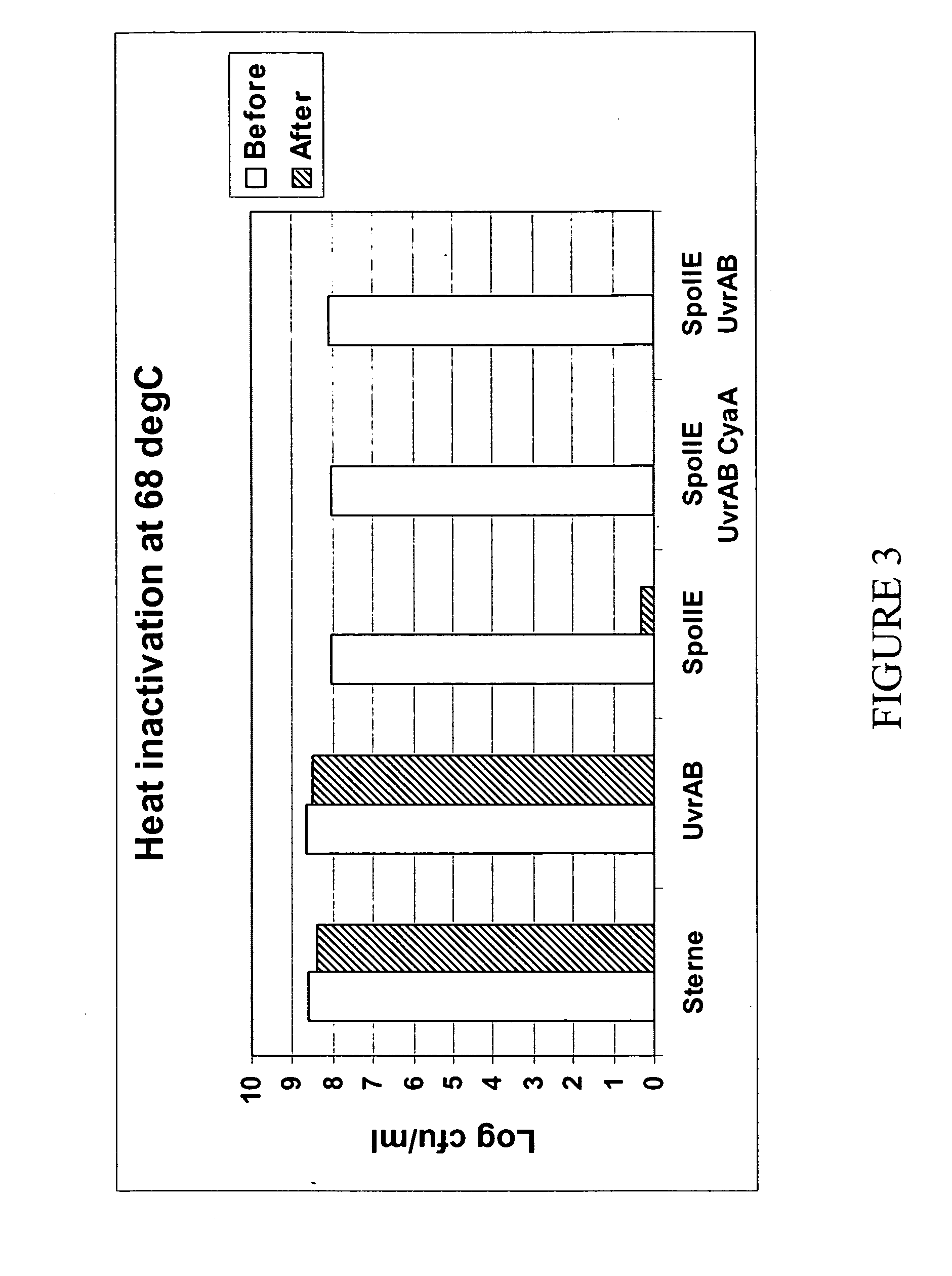Modified Bacillus anthracis, vaccine compositions and methods of use thereof
a technology of bacillus anthracis and vaccine composition, which is applied in the field of vaccine compositions and immunotherapy, can solve the problems of reducing the safety and effectiveness of the vaccine against bacillus anthracis, affecting the immunization of military personnel, and requiring annual boosters. the effect of reducing the toxicity of the strain
- Summary
- Abstract
- Description
- Claims
- Application Information
AI Technical Summary
Benefits of technology
Problems solved by technology
Method used
Image
Examples
example 1
Bacterial Vaccines Derived from Nucleotide-excision Repair (NER) Mutants
[0269] The examples described herein illustrate the efficacy of vaccine compositions utilizing genomic inactivation through photochemical treatment of the recombinant delivery platform encoding antigens related to infectious and malignant disease. According to this composition, while the genomes are inactivated and cannot separate during replication, the transcriptional profile remains largely intact, thus resulting in antigen expression de novo in the vaccinated individual, and optimal induction of pathogen-specific immune responses, including CD8+ cytotoxic T cells (CTL). Furthermore, by utilizing a vaccine platform in this composition in which the DNA nucleotide excision repair (NER) machinery has been inactivated by any number of means, including by engineered genetic deletion, the sensitivity to photochemical inactivation in these mutants is dramatically increased.
[0270] As a result of the requirement of ...
example 2
Construction of a Bacillus anthracis Strene ΔuvrAB.
[0281] The allelic exchange methods detailed in Camilli et al., Molecular Micro., 8:143-147 (1993) and as described in U.S. Patent Publication No. 2004 / 0197343 A1, for alteration of Listeria monogenes were used to modify the Bacillus anthracis Strene strain. The virulence of this strain is attenuated (pXO1+, pXO2−). All of the TOPO vectors used here were derived from pCR®2.1-TOPO® (Invitrogen, Carlsbad, Calif.).
[0282] The uvrAB gene from Bacillus anthracis was identified (Genbank accession number AE017040, Bacillus anthracis Ames strain, section 17 of 18 of the complete genome, uvrAB genes coding sequence: nts. 212613-217471) and a plasmid based on pKSV7 with the uvrAB gene deletion was constructed (pKSV7-dl uvrAB) using Splice Overlap Extension (SOE) PCR and the steps described below:
[0283] Primary PCR reactions: Approximately 1000 bps of sequence upstream and downstream from the B. anthracis uvrAB genes 5′ and 3′ ends, respecti...
example 3
S-59 / UVA Treatment of Bacillus anthracis Sterne Strain with and without uvrAB Deletion.
[0299] Two uvrAB−clones constructed as indicated in Example 2 (clone 8 and clone 32A) were S-59-treated, along with the parent strain, by growing in BHI at 37° C. at 300 rpm to and OD600 of 0.3, at which point 50 mL of solution was transferred to a clean flask and S-59 was added to the concentrations indicated in Table 2. These samples were incubated at 37° C. at 300 rpm with vigorous shaking for approximately 1 hour (OD600 approximately 1.0, approximately 1×109 / mL). A 1 mL aliquot was removed to assess the titer and the remaining was transferred to a 150 mm Petri dish and irradiated at a UVA dose of 6 J / cm2 (FX-1019), resulting in a six-log reduction in titer, as compared to the parental strain, as indicated in Table 2, below, and FIG. 1.
TABLE 2Attenuation of Bacillus anthracis Sterne strain vs. uvrAB− mutant withpsoralen S-59 / UVA treatment.Bacterial log titerLog attenuationS-59uvrAB−uvrAB−nMS...
PUM
| Property | Measurement | Unit |
|---|---|---|
| temperature | aaaaa | aaaaa |
| temperature | aaaaa | aaaaa |
| wavelength | aaaaa | aaaaa |
Abstract
Description
Claims
Application Information
 Login to View More
Login to View More - R&D
- Intellectual Property
- Life Sciences
- Materials
- Tech Scout
- Unparalleled Data Quality
- Higher Quality Content
- 60% Fewer Hallucinations
Browse by: Latest US Patents, China's latest patents, Technical Efficacy Thesaurus, Application Domain, Technology Topic, Popular Technical Reports.
© 2025 PatSnap. All rights reserved.Legal|Privacy policy|Modern Slavery Act Transparency Statement|Sitemap|About US| Contact US: help@patsnap.com



